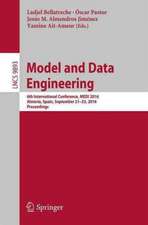Man-Computer Interaction: Human Factors Aspects of Computers & People: NATO Science Series E:, cartea 44
Editat de B. Shackelen Limba Engleză Paperback – 17 mar 2012
Din seria NATO Science Series E:
- 24%
 Preț: 1570.65 lei
Preț: 1570.65 lei -
 Preț: 397.76 lei
Preț: 397.76 lei -
 Preț: 386.81 lei
Preț: 386.81 lei - 20%
 Preț: 346.24 lei
Preț: 346.24 lei -
 Preț: 424.33 lei
Preț: 424.33 lei - 18%
 Preț: 1224.18 lei
Preț: 1224.18 lei - 18%
 Preț: 1836.63 lei
Preț: 1836.63 lei - 18%
 Preț: 1229.28 lei
Preț: 1229.28 lei -
 Preț: 381.00 lei
Preț: 381.00 lei -
 Preț: 409.30 lei
Preț: 409.30 lei - 18%
 Preț: 1841.36 lei
Preț: 1841.36 lei - 5%
 Preț: 367.28 lei
Preț: 367.28 lei -
 Preț: 407.19 lei
Preț: 407.19 lei - 18%
 Preț: 1838.38 lei
Preț: 1838.38 lei -
 Preț: 420.28 lei
Preț: 420.28 lei -
 Preț: 399.29 lei
Preț: 399.29 lei -
 Preț: 398.74 lei
Preț: 398.74 lei - 18%
 Preț: 3026.13 lei
Preț: 3026.13 lei -
 Preț: 388.90 lei
Preț: 388.90 lei - 5%
 Preț: 391.06 lei
Preț: 391.06 lei - 18%
 Preț: 1228.62 lei
Preț: 1228.62 lei - 18%
 Preț: 1229.73 lei
Preț: 1229.73 lei - 18%
 Preț: 1234.46 lei
Preț: 1234.46 lei - 5%
 Preț: 3532.05 lei
Preț: 3532.05 lei - 18%
 Preț: 1840.11 lei
Preț: 1840.11 lei - 5%
 Preț: 378.80 lei
Preț: 378.80 lei - 18%
 Preț: 1227.84 lei
Preț: 1227.84 lei -
 Preț: 392.75 lei
Preț: 392.75 lei -
 Preț: 395.63 lei
Preț: 395.63 lei - 18%
 Preț: 2489.30 lei
Preț: 2489.30 lei - 5%
 Preț: 1429.27 lei
Preț: 1429.27 lei -
 Preț: 396.02 lei
Preț: 396.02 lei - 5%
 Preț: 2142.61 lei
Preț: 2142.61 lei - 18%
 Preț: 3049.16 lei
Preț: 3049.16 lei - 18%
 Preț: 1844.54 lei
Preț: 1844.54 lei -
 Preț: 403.53 lei
Preț: 403.53 lei
Preț: 403.91 lei
Nou
Puncte Express: 606
Preț estimativ în valută:
77.30€ • 79.85$ • 64.33£
77.30€ • 79.85$ • 64.33£
Carte tipărită la comandă
Livrare economică 25 martie-08 aprilie
Preluare comenzi: 021 569.72.76
Specificații
ISBN-13: 9789401175883
ISBN-10: 9401175888
Pagini: 572
Ilustrații: 570 p.
Dimensiuni: 155 x 235 x 30 mm
Greutate: 0.79 kg
Ediția:Softcover reprint of the original 1st ed. 1981
Editura: SPRINGER NETHERLANDS
Colecția Springer
Seria NATO Science Series E:
Locul publicării:Dordrecht, Netherlands
ISBN-10: 9401175888
Pagini: 572
Ilustrații: 570 p.
Dimensiuni: 155 x 235 x 30 mm
Greutate: 0.79 kg
Ediția:Softcover reprint of the original 1st ed. 1981
Editura: SPRINGER NETHERLANDS
Colecția Springer
Seria NATO Science Series E:
Locul publicării:Dordrecht, Netherlands
Public țintă
ResearchCuprins
1 Introduction.- Man-Computer Interaction (MCI) — reality and problems.- 2 Conversation and communication.- Improving the communication between people and computers.- Some characteristics of conversations.- Interactive human communication: some lessons learned from laboratory experiments.- 3 Aspects Of the hardware interface.- Office computerisation in Sweden: worker participation, workplace design considerations and the reduction of visual strain.- Man-computer interaction in public systems.- 4 Aspects of the software interface.- Interactive software for humans.- The empirical study of computer language.- Towards a design for an on-line scheduling aid.- 5 Training and education.- The role of user support.- Problems of man-computer interaction in education and training.- 6 Manager and organisation.- A task-tool analysis of manager-computer interaction.- The impact of computer-use on organisation structure.- Strategies for the human use of a computer-based system.- Approaches to determining functional needs of information system users.- 7 Modelling and problem solving.- Modelling the user.- Outlook for man-computer symbiosis: toward a general theory of man-computer problem solving.- 8 Specialist Users.- The specialist user.- Man and computer in future on-board guidance and control systems of aircraft.- Dynamic graphical interaction in engineering design.- 9 Evaluation and the wider context.- Evaluating man-computer systems.- Epilogue.- Appendices.- 1. Contributors to this book.- 2. Institute participants.- 3. Institute programme.






















